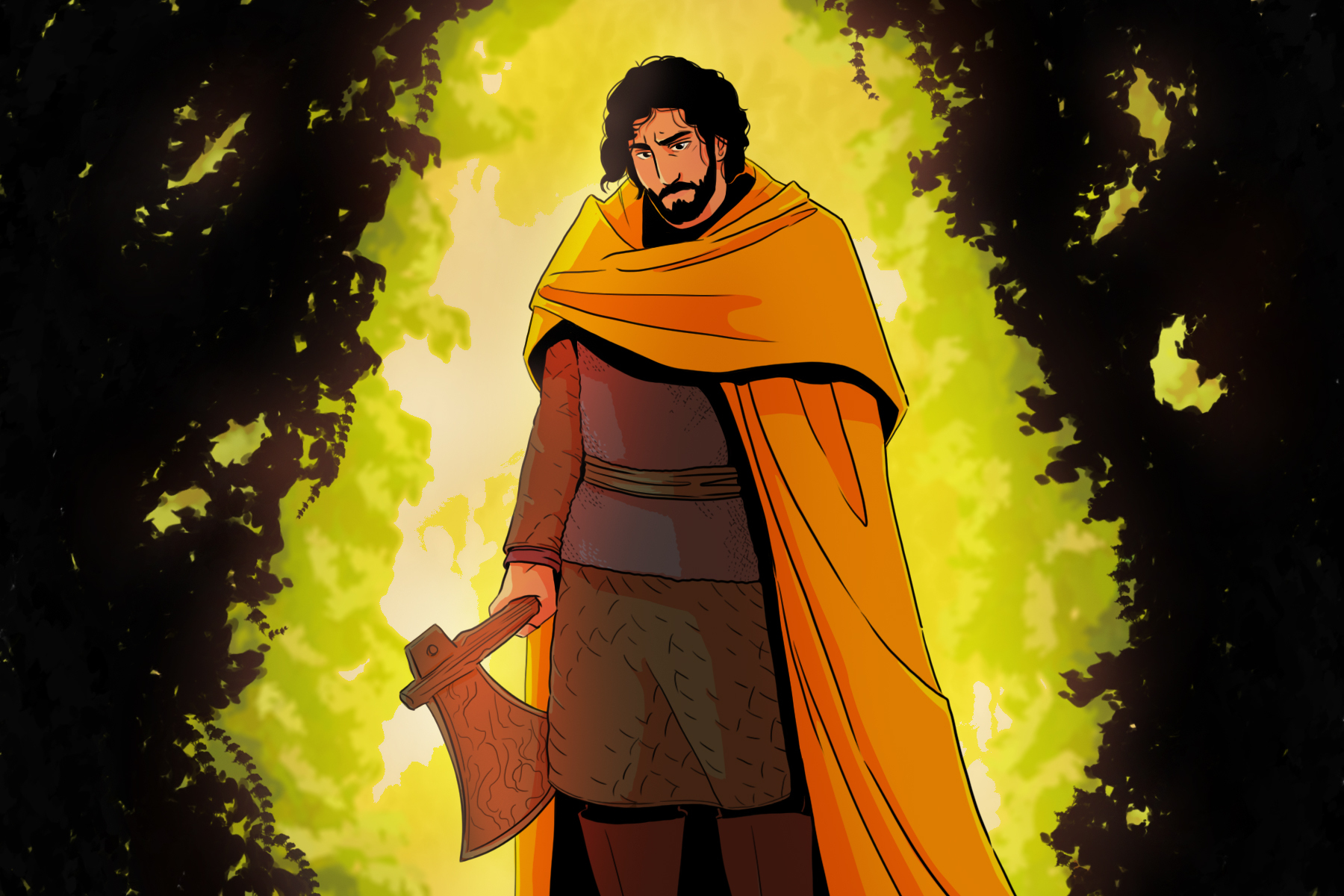The opening scenes of David Lowery’s “The Green Knight” put a taste in audiences’ mouths that lingers throughout the two hours to come. The camera studies a snow-dimmed and bleak English countryside, populated only by a couple of farm animals and a lonely yellow-windowed, still-surviving hut.
The scene evokes the same feeling one might experience while traipsing red-nosed through the woods, closing the door against cold air and staring out the window at the wilderness waiting to eat you alive. As Roger Ebert reviewer Brian Tallerico wrote, “You can feel the chill and smell the air. Immediately, you feel outside yourself, far from daily concerns, set for an experience that’s unlike anything else in nearby theaters.”
And boy, is Tallerico right. The feeling of quiet otherworldliness that permeates “The Green Knight” makes for a fascinating retelling of the medieval adventure poem that follows the mythical everyman at the center of the story.
The plot lurches forward when a mysterious, 10-foot-tall figure interrupts Arthur and his court, which happens to include Arthur’s nephew, Gawain. Until now, the audience has mostly seen Gawain living in the bawdy hut in the woods, longing to earn the honor of the knights who surround him.
The Green Knight, who seems to be made of green wood (for “The Lord of the Rings” fans, think of an Ent), offers a high-stakes game to anyone who dares to participate: Strike any blow on the knight’s clearly magical body, wait a year and then seek the knight out in his mysterious Green Chapel to receive the exact same blow from him. Gawain rises to accept the Green Knight’s challenge before the court.
As viewers watch the everyman’s journey that follows, they may find themselves surprised — not simply with the movie’s plot and characters, but also with Lowery’s meticulous visual and sonic detail, which elevates mediums like typography from mere tools of communication to purposeful works of art.
The aspect of the film that takes center stage, however, is its setting. A.O. Scott of The New York Times wrote, “England in wintertime has rarely been gloomier, and when the wan daylight fades you have to squint and crane your neck to see what’s going on.”
Through shots of rolling barren fields, creeping oaky forests and stark, grass-covered hills, Lowery gives nature itself the impact of a character. In particular, his understanding of lighting is exemplary, masterfully contrasting light and dark as well as midtones and brights. Against these eerie backgrounds, Gawain’s burnt yellow scarf lights a candle, tickling audiences’ synesthesia. Viewers may itch for a pumpkin spice latte.
Beyond visual mediums, even the sound design in “The Green Knight” plays out with the intentionality of art rather than as a simple “mood-setter.” It rings out in key moments with either high elven choruses or deep, rhythmic beats and drums.
Scott concurred, writing that, “Lowery, a master of spooky atmosphere and metaphysical mummery … starts the movie with horror-movie sound effects, spells and flames and tremors of spooky portent. As seriously as he takes the spiritual and moral significance of the story that follows, he is also clearly having fun with it and with us.”
All of these sensory experiences create a synergy that may strangely touch viewers, as the effort indicates that the audience’s two-hour experience is worth the labor of their time and energy.
The nuance of the movie’s characters only strengthens this effect. Lowery makes sure to construct the classic male characters of the Arthurian legend with fearful, relatable and resilient personas, but he also does the same for the tale’s lesser-known female characters. Arthur holds vulnerability and honor in the same hand, Gawain’s mother Morgan le Fay surmounts the odds as a Christian witch and Essel — played stunningly by Alicia Vikander, who also portrays another significant character in the film — challenges her lover, yet also trusts him with a childlike naiveté.
None of these supporting characters, however, receive nearly the same amount of screentime as Gawain, played by Dev Patel, who cuts his way through the wilderness before him with irresolute single-mindedness. Patel enlivens Gawain like a lightbulb in a salt lamp, exuding absorption, fear and decisiveness. His performance helps make a movie with little dialogue feel emotionally rich and nuanced, largely due to his dark, imploring eyes and clear body language.
Toward the end of the film, however, an emotion besides respect and awe rises in viewers, then abruptly smacks them on the head. Is Gawain a relatable everyman, or a fermenting villain? What exactly is “The Green Knight” trying to say? Most importantly, what the heck is going on?
To call “The Green Knight” trippy would be an understatement. The plot of the movie circles in on itself, mirroring the 14th-century poem it roughly follows. In particular, the movie’s ambiguous ending leaves viewers uncertain whether to congratulate or mourn Gawain — unsure enough for Vulture to publish an article titled, “The Green Knight’s Enigmatic Ending, Explained.”
After a few minutes of pondering, talking to their friends or perhaps making a quick online search, audience members grasp “what really happened.” However, the story’s meaning takes a few more minutes to naturally unfold, as the viewers themselves begin to learn the lesson Gawain struggled to grasp for so long.
Still, the beguiling, nonlinear format of “The Green Knight” and its source material beckon its viewers onward. What is the strange world of the poem, anyway? And how does it interact and overlap with audiences’ own everyday lives?
















